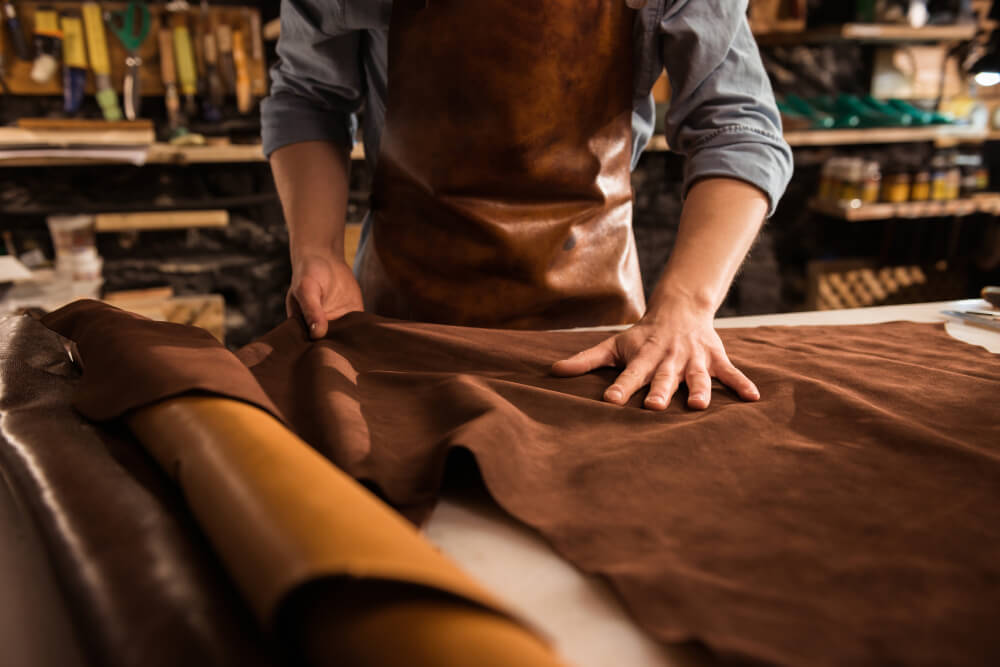How To Dye Leather? A Step By Step Guide

Leather is one of the most common materials that we use for different purposes. Whether it is clothing or other things, most people prefer to use leather accessories as they are both long-lasting and good-looking. However, before you find out how to dye leather, there are some other things you need to know.
Humans have been using leather for a long time now. Leather is made from animal skins mostly. However, there are many other artificial ways available to create leather-like material now. You can find leather bags, wallets, coats, footwear, sports equipment, furniture, and others. They provide better durability and protection from different weathers.
Why Does Leather Dyed?
After processing the animal hides, dying the leathers gives a perfect look. But that is not the only reason to use dye on leather. The natural color of the leather is not very attractive. So color is used to give it a brown, tan, or any other look. Many people also dye the leathers to match them with their outfits or other belongings.
Also, dying the leathers help to get rid of any bad smell of the original leather. However, make sure to use the right colors as the wrong colors can ruin the leather. Now that you know why dying leather is essential let’s dive in to find out how to dye leather armor or other accessories.
Step By Step Guide To Dye Leather
The process of dying leather is very tricky; only people with skills can do it. But, apart from skill, you need to know what the process is to do it perfectly. Here is the step-by-step process that you can follow to dye leathers easily.
Step 1: Leather Preparation
It is the first step of dying that ensures the leather is ready to get dyed. First, you need to wear gloves for the process. You can get your hands dirty without wearing them. So, make sure to have them on through the process. Next, you need to make sure that the room you are in has a good ventilation system. Oil dye fumes can be very harmful to your health if you stay for 1-2 hours.
So, make sure that the ventilation process is very well in the room. Even a window fan is enough to circulate air and keep you safe. In the first step of how to dye leather, you have to choose the right leather. There are not many things to keep in mind, but they are important. Most of the lathers have waxed on them which makes it hard to apply the dye.
Also, If the leather is 100% top-grain, then it is very good for quality, but the top layer will be there. So, the spots and imperfections will prevent you from having a smooth dye on the leather. If the leather is kept for some days before dying in the same place, then it develops crap on it.
You need to wipe down the leather very well before starting the dying process. It will not only make the dye go smooth on the leather and even in every place. You can use a deglazed to remove any oils and other things from the leather. It is the best way to make it completely clean before dying.
Step 2: Choosing Dye
When you are completely prepared with the leather, you need to choose the dye color and quality. There are many different types of dyes available such as water-based, oil-based, and others. The color depends on how many coats you are using. However, choosing the right one is also necessary to make the process faster.
If you are using the water-based dyes, use some Neatsfoot Oil after coats to make the oils go back inside the leathers. While choosing the colors, do not let the shown color in the vial fool you. You can choose between spray-on, paint-on, sponge-on to dye the leather-based of your choice.
Step 3: Base Coat
When you are done with preparation, you will need to start the leather’s first and most essential coat. However, before doing the base coat, cover all the areas you do not want to paint. Take the help of tape to cover the areas very well and keep the color from getting in. Masking tape is the best choice to cover the areas. It will help you to dye without worrying about these areas.
After covering the areas, you will need to begin the base coat. Use a piece of cloth or sponge to apply the dye. Rub the leather in circles until all the areas are covered. Give it some time to dry before using any more coats. You will carry a lot of dye in the first dip; avoid pressing the cloth or sponge while applying, not to create any patches.
Use cloth pieces to dye the edges of the leather very well. Leaving them will make them look less dyed than the other areas. If you want to know how to dye leather couches, edges are one of the most important things. While applying the coat, make sure to make all the areas look even. You can use paintbrushes to dye some of the areas.
Step 4: Second Coat
After the base coat is done and completely dry, you will have to apply the second coat. In this coat, you have to use the dye both diagonally to the left and right. Sideways applying procedure helps to hit the grains from every side. If you are unable to get the color you want, try mixing them with other colors. Let the leather completely dry after the second coat is done.
Step 5: Finishing
It is the last step of how to dye leather, where you will have to make sure that the dye is protected. You have to apply a finish on the leather to give it a perfect look and prevent the dye from getting on clothes. Choose any finish you want and apply them circularly. Let it dry for some hours, and it will be ready with a smooth, colorful finish.
Conclusion
Although, you will need a lot of practice to dye leather perfectly. You can follow the steps to do it like a professional. Give a new look to all leather accessories, and make them look more attractive.
Additional Reading:












